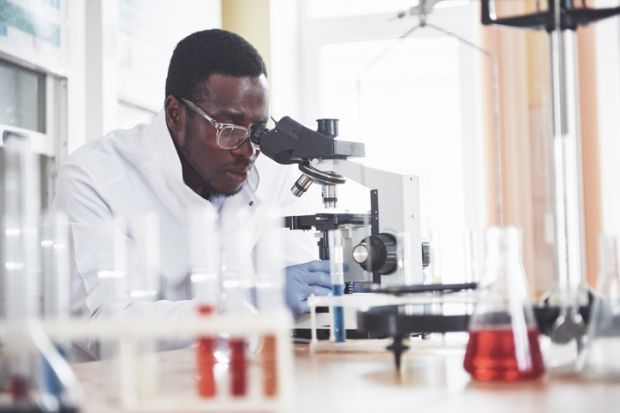The murder of George Floyd has caused outrage across the US and the world, forcing everyone to confront the fact that the goal of racial equity remains a distant one.
This is as true in the academy as it is in Minneapolis’ police service. In the past few years, we have seen a huge movement in academia led by students of colour to “decolonise the curriculum” and open up conversations around race. As a bioscientist, I was hopeful that the movement might eventually arrive in our departments. Unfortunately, this hasn’t happened. The main opposition to “decolonising” science is the persistent belief that science is objective and neutral. Yet if scientists live in a society with enormous biases, how can science be objective?
Injustices can be found in almost every scientific discipline. Weaving the origins of those injustices into the way the curriculum is delivered could actually make for a more engaging learning environment.
James Watson, who won a Nobel Prize for the discovery of the structure of DNA, expressed the view that “There’s a difference on the average between Blacks and Whites on IQ tests. I would say the difference is genetic.” He was also “inherently gloomy about the prospect of Africa” because “all our social policies are based on the fact that their intelligence is the same as ours”. Watson’s vocal racism is not, of course, backed by any scientific evidence. While my first-year lecture on DNA mentioned Watson and Francis Crick by name, it failed to include the former’s racist ideologies. It also failed to mention Rosalind Franklin, whose contribution to the discovery was sidelined and essentially unacknowledged because of sexism. We need to think seriously about what these omissions say to students.
Although Watson went on to lose both his job and his honorary titles due to his (still unchanged) views on race, he has many university buildings named after him and is idolised in science education in a way that suggests that racist views can be overlooked if the discovery is significant enough. Some undergraduates still don’t really understand why race is not a legitimate human category. Talking about Watson’s racist ideologies allows us to have a crucial scientific discussion in a dynamic way.
Even on the rare occasions when science curricula address ethical issues, it is conveniently omitted that most of the scientific progress made since the Enlightenment has been carried out in societies where black people were not even considered full human beings. Major medical innovations relied on experiments performed on slaves. An example is the modern form of vaginal speculum, invented by the “father of modern gynaecology”, James Marion Sims. Sims performed horrific experiments on enslaved black women, most of the time without anaesthetic. By neglecting to teach students about such atrocities, are we sending a message that the means are not as relevant as the scientific breakthrough?
Although some forms of race science were discredited by their association with the Nazis, contempt for racial minorities persisted – and for some scientists, the ends continued to justify the means. A highly relevant example is the creation of the HeLa cell line. Widely regarded as the world’s first immortal cell line, this is widely used in biochemistry and molecular biology research, and has led to significant pharmacological discoveries. The problem is that the cells were stolen from a black cancer patient called Henrietta Lacks in 1951. The scientists probably didn’t ask for permission because they lived in 1950s Virginia, an American state that enforced racist Jim Crow legislation that made its black citizens second-class by law.
Recent healthcare statistics show us that racist contempt continues. In the US, black patients are over twice as likely to be denied appropriate pain medication than white patients, and black women in the UK are five times more likely to die in childbirth than their white counterparts. Research into the contributory factors in the former case found that some medics held highly problematic pseudoscientific views, such as that black people have higher pain thresholds or thicker skin or are more prone to drug addiction.
These are just a few of the examples scientists in academia can and should use to discuss race, because, unfortunately, students are often discouraged from raising them. Jarita Holbrook, associate professor of physics at the University of the Western Cape in South Africa, stated that, “Black students have their capacity for objectivity questioned simply because their standpoint on racism is different from that of white students and scientists who don’t have to experience its consequences.” Some of the science fields that perceive themselves as being the least prone to bias show large racial gaps in degree awards in universities across the UK, including my own. One of the factors consistently cited by black students is a curriculum which fails to represent them and their experiences.
A lot of black and ethnic minority students can already see the inequality in science. Knowing the reality behind many scientific discoveries but having it completely ignored in education feels like gaslighting.
Instead, encouraging science students and academics to confront and discuss race in the context of their subjects might increase engagement and a sense of belonging for students of colour. But it’s also important for white students. All students need to understand the historical context for what they learn – a critical first step in ensuring history does not repeat itself.
Daniel Akinbosede is a doctoral tutor in biochemistry at the University of Sussex.
Register to continue
Why register?
- Registration is free and only takes a moment
- Once registered, you can read 3 articles a month
- Sign up for our newsletter
Subscribe
Or subscribe for unlimited access to:
- Unlimited access to news, views, insights & reviews
- Digital editions
- Digital access to THE’s university and college rankings analysis
Already registered or a current subscriber?










